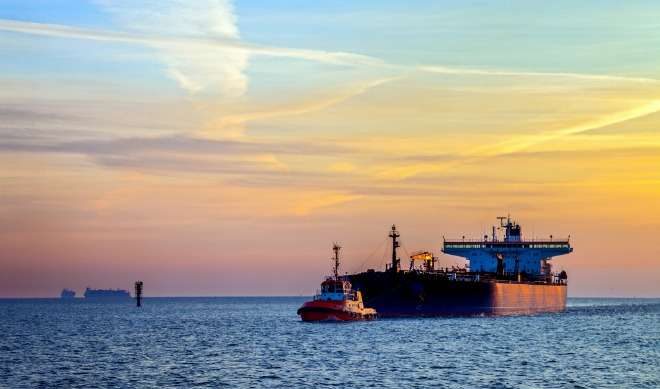If you have spent the last 40 days or so under your desk wearing a tin foil hat to keep out the geopolitical noise, then you have my sympathy. As the new US administration thrashes about breaking stuff, traders and investors have displayed a curious calm, or perhaps an unwillingness to take a position until there is more signal to be discerned among the noise.
Still, there are some facts to be reported. Oil prices have been falling with WTI losing over $4.60 in the 30 days to February 21 to sit at $70.40. Brent is down over $4 to $74.43 between the same dates. The OPEC basket price fell from $80.45 on January 24 to a low of $76.24 on February 13 but was back up to $78.19 on February 19. US oil exports should therefore be favourably priced for Far Eastern buyers but freight rates suggest weakening demand. The daily TCE for a VLCC sailing from the US Gulf to China slid steadily from $52,080 on January 21 to $41,827 on February 21. Contrarily the daily TCE for a VLCC from the Middle East to China fell only 9% from $46,108 to $41,739 while the TCE for the voyage from the Middle East to Singapore was down 8% to $44,671. China’s teapot refineries are being squeezed by sanctions on Russian oil (for now) and increasing import taxes on feedstock. This may affect spot oil purchase volumes with some reports saying four refineries with annual output of 18m tonnes are indefinitely shuttered.
Suezmax tanker owners have fared better with the Baltic Exchange reporting a 24% increase in daily TCEs on the WAF-UKC voyage to $36,391 on February 21, the highest level since October last year. The Guyana-ARA suezmax TCE was up 26% over 30 days as of February 21, sitting at a lively $33,657 having surpassed $36,000 a few days earlier. Are EU buyers switching to Guyanese feedstocks over logistically difficult Middle Eastern supplies? The suezmax TCE from the Middle East to the Med lost 19% over 30 days to lounge at $38,791 on February 21.
Who knows where Messrs Trump and Musk will push the global oil markets?
The diverse aframax freight markets were on average rising in February, with some variation. Day rates from Kuwait to Singapore rose 2% to $30,891 while from Singapore to Australia the TCE assessment rose 7% to a still slim $20,910. In the Med, TCE assessments fell 14% to a still meaty $32,235 while aframaxes trading from the USG to ARA were rated at $31,967 on February 21, some 26% higher than a month earlier. The biggest rises were in the North Sea, with discharge in the UK returning $48,249 on February 21, up 70% over 30 days, and discharge in Germany returning $28,265 per day as per even date, up 35%.
As crude oil markets wait for a geopolitical steer, oil products tanker markets have been volatile. For instance, the Atlantic MR basket moved from $27,030 on January 21 to a peak of $30,217 on February 4 before slumping to $15,755 on February 13 then regaining ground to sit at $22,391 on February 21. Daily TCEs on the eastbound voyage from the USG to ARA, affected by refinery maintenance, functioned as the sea anchor on rates, which have been stuck in four figures for all of February, averaging just $7,336 per day. Rates from the USG to the Caribbean looked flat, falling just 2% to $10,681 over the 30 days to February 21 but this masked a slump to just $4,256 on February 12 and subsequent recovery. Rate assessments on the westbound voyage from ARA to the US north east coast were also down 15% over 30 days albeit to a more consoling $16,090 per day.
In the Pacific, MR earnings from South Korea to the US west coast were steady at $24,899 on February 21 having averaged $24,763 for the previous 30 days. However rates on the voyage from South Korea to Singapore fell by 16% to $14,139 whereas the MR day rate from South Korea to Australia rose 5% to $18,415. The TCE assessment on the MR tanker voyage from Singapore to the east coast of Australia rose by a hefty 22% to $20,260. From these data the Pacific looks rather positional and short-term with little overall direction.
The benchmark LR2 voyage from the Middle East to Japan lost 30% over 30 days to February 21 to sit at a mediocre $22,845, while the mirror voyage from the Middle East to western Europe lost 34% over the same dates, to end up at $26,143. The daily TCE for an LR2 sailing from Algeria to Japan lost 30% with rates subsiding to a miserly $6,862.
Where LR2s go, LR1s usually follow, so the daily TCE from Jubail to Rotterdam lost 17% to lie at $20,906 on February 21. The assessed TCE from the Mid East to Japan on an LR1 lost 12% to end up at $17,748 though it had dipped to $12,689 on February 2. However, from ARA to WAF, LR1 earnings added 18%, achieving $20,434 on February 21, while the cross-Med route to the EU gained 5% to reach a tasty $30,786 per day having dipped as low as $17,726 on January 30.
Over the last 30 days the Baltic Dirty Tanker Index is up 1% and the BTCI is down 5%. The year has really yet to get going, and who knows where Messrs Trump and Musk, the Bert and Ernie of geopolitics, will push the global oil markets, the sanctioned tanker fleets or global oil supply chains?

